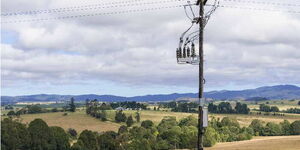UPDATE: The fire that razed down over 4,000 acres within the Tsavo East National Park on Friday, May 29, was attributed to a boy who was burning litter at a village called Lebanon in Voi.
The Kenya Wildlife Service (KWS) team, with support from personnel from the David Sheldrick Wildlife Trust, were able to contain the raging inferno in the wee hours of Saturday Morning, May 30.
"Both ground and aerial teams have affirmed that the fire has been totally contained and that no big game was affected.
"The fire started in a village known as Lebanon, 15 kilometres from Voi town at 3:00 p.m. Initial investigations indicate that the source of the fire was from a boy who burning litter," a statement issued by the KWS reads in part.
An inferno that broke out at the Tsavo East National Park on Friday, May 29, has reportedly destroyed 4730.6 acres of land at the wildlife conservancy.
Reports indicate that the fire that commenced in the mid-afternoon hours consumed vegetation fiercely propelled by the dry and windy conditions of the area.
The Kenya Wildlife Service (KWS) officer who responded to the fire stated that they had made [some] effort to contain the fire.
"Please spare a thought for KWS Rangers and volunteers who have been battling bushfire that erupted late afternoon in Irima area. Let's pray for heavy rain to extinguish the flame," read a tweet from the conservation agency on Friday.
The agency is yet to give a comprehensive statement on the progress of the fire and efforts to put it off.
Tsavo East park forms the largest protected area in Kenya and is home to most of the larger mammals, vast herds of dust –red elephant, Rhino, buffalo, lion, leopard, pods of hippo, crocodile, waterbucks, lesser Kudu, gerenuk, and the prolific birdlife which features nearly 500 recorded species.
The destruction of large tracts of land puts the habitats of the animals at risk. Whereas larger animals are able to move, smaller ones may get trapped and burnt as the fire spreads.
Speaking to Kenyans.co.ke, the Head of Botany Department at the National Museums of Kenya (NMK) Dr. Paul Musili explained that the effects of a huge fire could take up to years to repair.
"In such an inferno small insects will die, burrowing animals will have nothing to eat and as the vegetation gets burnt, there is no forage and the big animals as well may die of starvation if they can't move to another habitat," he explained.
Dr Musili added that the smoke was also contributing to pollution as trees and herbs in the ecosystem are destroyed in the fire.
According to a report by the World Health Organisation, in 50 percent of wildfires recorded, it is not known how they started.
"The risk of wildfires increases in extremely dry conditions, such as drought, and during high winds. Wildfires can disrupt transportation, communications, power and gas services, and water supply. They also lead to a deterioration of the air quality, and loss of property, crops, resources, animals and people," the global body noted.
The last major wildfire reported in Kenya occurred at the Mount Kenya National Park in March 2019.
The Kenya Forest Service reported that over 100,000 hectares of moorland had been destroyed in the inferno that lasted for over a week.












